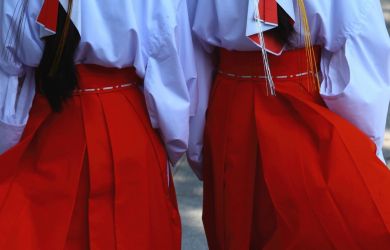
December 29, 2011
Getting Sourcey with the Crowd
The aces behind some key 3/11 crowdsourced charity arts efforts
By Metropolis
Originally published on metropolis.co.jp on December 2011
If the Arab Spring was the first socially-networked revolution, 3/11 was the first crowdsourced mega-disaster. Facebook and Twitter came into their own, delivering streams of information from the ground, and bringing victims and volunteers together with unprecedented speed.
Through networks like the Facebook group Foreign Volunteers Japan, expats in Japan were sometimes at the forefront of relief efforts. But crowdsourcing was also the engine for some groundbreaking charity art expressions by foreigners. These social networking-driven responses to disaster collected considerable funds while offering a new kind of peer-led, artistic reaction to tragedy.
Nine months since 3/11, we catch up with the individuals behind Quakebook, the digital album Kizuna and the photographic exhibition My Japan. We also preview what may turn out to be the most unusual crowdsourced charity project to emerge out of the disaster. Now in the making, Bikini Lines will see artists create the world’s largest painting on the Cactus Dome, which houses radioactive debris left from nuclear testing in the South Pacific’s Marshall Islands.

Quakebook
An English teacher and former newspaperman living on the outskirts of Tokyo, Our Man in Abiko used his Twitter blog to solicit contributions for what became Quakebook.
Tell us about Quakebook’s charitable accomplishments.
Our Man in Abiko: Around 50,000 ebooks have been downloaded to Amazon Kindle users and around 2,000 print books sold as of November 1. In total, around $50,000 has been raised so far for the Japan Red Cross, and the book will be downloadable forever, so the figures can only grow. We have just launched a print-on-demand hardback bilingual edition, which means anyone, anywhere in the world will be able to order it from Amazon or any other bookstore.
How has the response been to Quakebook from readers, and were there any parts they liked in particular?
Our Man in Abiko: Overwhelmingly positive. I think everyone has a different favorite story. People were pleasantly surprised at the high quality of the book and the writing, considering it was pulled together in a week. But they shouldn’t be. A lot of talented people worked very hard on it. And not only the famous contributors like Yoko Ono, William Gibson, Barry Eisler and Jake Adelstein, but the non-celebs too. It will be interesting to see how the book holds up over time. Already, people have commented that rereading it brings back many emotions from 3/11 that they had forgotten.
What did you learn about crowdsourcing in the process of creating Quakebook?
Our Man in Abiko: That people are willing to give a lot if you, as editor, are willing to trust them. But the result may not be as you at first intended. And that the final result is greater than its individual parts. What came out at the end was greater than anything any one of us could have managed on our own. But it was a lot of work.
What did the experience tell you about Japan and the expat community?
Our Man in Abiko: That we should get over ourselves. We are not just expats or Japanese or gaijin or whatever label we think fits. We are human beings and we are here and people are in need. So help them. And we have. And we continue to need to.
Where do you see things going from here with Quakebook?
Our Man in Abiko: You can’t repeat what we did in the weeks following 3/11. Quakebook was exactly the right response at that time. Now, the immediate need for relief has gone. What is still needed is an understanding of how 3/11 affects us today, and working to help communities to rebuild for the long-term. This is a challenge beyond the remit of Quakebook, but it will always exist and serve as a reminder about what happened in the moments after 2:46 on March 11, 2011. I’m profoundly moved by what we were able to achieve under the circumstances, and I hope it continues to serve as an inspiration for the future.
Nihon Kizuna

French/Italian producer and erstwhile Japan resident Laurent Fintoni landed in Tokyo less than 24 hours before the disaster. Within a month his crowdsourced compilation Nihon Kizuna had topped Japan’s iTunes electronic charts.
How did Nihon Kizuna sell, and how much did you raise?
Fintoni: This being a digital release it’s hard to put an exact number of “copies” sold but in Bandcamp—our primary sales platform—we’ve sold over 1,300 copies of the Nihon Kizuna and Nihon Kizuna bonus albums, plus a few hundred individual tracks as well. I believe we did around 500 copies in iTunes as well. We raised over $30,000 altogether, which after each platform takes its cut (Bandcamp, PayPal and iTunes) means we’ve donated around $24,000 to the Japanese Red Cross so far.
What did you discover about crowdsourcing through Nihon Kizuna?
Fintoni: That it’s an amazing way to turn big projects around quickly, but it also requires a lot of effort. I guess the main lesson for me is that these kinds of crowdsourced projects with a charity element really do bring the best out of everyone. Every artist and label we worked with on this has been incredibly supportive and amazing in their own way. As has everyone who put their money where their mouth is. So I’d like to take this opportunity to thank everyone again.
How has the reaction been?
Fintoni: Great, from everyone involved and everyone who purchased and helped us to promote it. I know a lot of the artists and labels involved personally and they’ve all been incredibly responsive and proud to be involved, as have we in putting it together. It seemed to have really captured the feelings worldwide shortly after the event and while interest in the compilation has faded since then, I always bump into people who have heard it or bought it and have nothing but good things to say.
What did you learn through the process?
Fintoni: The biggest lesson was the reaction of my Japanese friends—especially the artists and labels. They were all amazed that so many foreigners, especially artists who’d never been to Japan, were willing to contribute. I think this is the key thing for me about both Nihon Kizuna and the March 11 experience—the fact that it’s shown Japanese people that the outside world cares more than they might have ever thought. I really do believe March 11 has changed Japan forever, and it will take years for these changes to take effect fully. So my biggest lesson was to see the emotions it created among the Japanese.
Where do you see things going from here with Nihon Kizuna?
Fintoni: This is something I’ve been giving a lot of thought to lately. Ultimately NK was a spontaneous response to events around us and I’ve always felt uncomfortable with trying to make it more than just that. For now it will continue to stand as it is, but I’m looking at ways in which it could be continued in the future. One element is to bring more of the Japanese artists from the compilation over to Europe. Beyond that I’d like to do something around the first year anniversary of the earthquake next year. It’s unlikely to take the shape of another compilation unless something appropriate comes up. I’d love to continue building on the goodwill that made this possible but I’m also acutely aware of what that can end up implying and maybe also a little too cynical due to my own experiences within the music industry.
My Japan

South African-born art consultant Liezel Strauss asked the world to submit photos answering the question, “What does Japan mean to you?” Over 700 people from more than 20 countries answered the call on Facebook.
How much have you raised, and where did you donate it?
¥220,000, and all our proceeds go to JEN NPO.
What did you learn about social networking through My Japan?
Strauss: I learned first and foremost that there are so many people out there that care. It also confirmed to me that social media is a very powerful tool. I learned that crowdsourcing is a wonderful way of building a community to reach a common goal. I also learned that you have to play by the rules of social media if it is crowdsourced, and that the outcome is unpredictable and not always what you expected. Lastly I learned that it is not a free tool but takes a lot of time. To manage the logistics at the backend and you need to dedicate a lot of time to keep the project “hot and happening.”
What is people’s socially networked image of Japan?
Strauss: Most people don’t think of Japan as a disaster area, but as a very magical, beautiful place. I also learned that the expat community wants to help and wants to get involved. They just don’t always know how.
What is the future for My Japan?
Strauss: We’ve had so many messages from people saying they love coming to the site and “paging” through the photos. We are told it reminds them of the joy and beauty of Japan. Some people have “explored” Japan for the first time through the pictures. That is exactly what we wanted, to spread the joy, beauty and good news through the power of imagery. So we will continue the project and let it grow organically. We hope people will continue to upload. And we will continue to do the marketing and find sponsors for the exhibitions. We would like to get involved with the Japan Tourism Board. To some extent this project has been successful, but we still want to raise a lot more money for JEN NPO. We also have other big dreams for this project—to extend it to other countries struck by disasters, such as “My Haiti” or “My Thailand” for example. We would like to do My Japan exhibitions in other cities and countries. We have plans for London and Cape Town next year, most probably on 3/11.
Bikini Lines

Inspired by the panic that followed the nuclear meltdowns, Bikini Lines is a crowdsourced project to create the world’s largest painting. The concept grew out of Canadian producer Christian Forestell’s experience in the online, communications and venture capital fields.
How did your frustration over the nuclear disaster reporting lead to the Cactus Dome/Bikini Lines concept?
Forestell: Safe journalism is often vague, and sensationalism equals sales numbers, so reporters hiding behind broad claims of “____ millirads/hour” could claim numbers without needing to back up their reports. Effective journalism as it pertains to people actually learning something would teach what a millirad is, and then back up these findings with easy-to-identify examples. The Cactus Dome is both a forgotten obscurity and rich slurry of concrete and radioactive soil, and has a similar stigma attached to it: while being declared qualitatively safe (for 30 years), do the numbers add up in a meaningful way that people can understand? Living there, ritualistically painting it, monitoring the radioactivity, and generally making a grand gesture is simply our way of saying, “These are the numbers: Learn to tell us what’s safe.”
Why crowdsource Bikini Lines?
Forestell: By asking people to finance the project $1 at a time we’re promoting the need for people to do something, not governments or companies. Paying the price of admission, however small the cost, has also historically been shown to keep people interested, focused and honest.
What is your previous experience with crowdsourcing?
Forestell: I have a pretty significant background in helping to create collaborative systems, which take CGM concepts and place them in a micro-financed, merit-based hierarchy. I’ve been drawn to the “game theory” aspects of closed system crowds for some time, though this is not my educational background.
What are the risks/benefits of crowdsourcing?
Forestell: Quality control is a big risk that can be overcome with merit-based group collaborative measures. We’re using Kickstarter to finance our project (fingers crossed!) but have purpose-built systems to ensure that only the best media is used officially. Easily the greatest benefit of crowdsourcing, though, is the viral nature of it: social networks act as their own meritocracies and the best ideas filter through them blindingly fast. Word-of-mouth marketing and referrals are the best compliments an idea can hope for. Success in crowdsourcing is a very pure thing, because it relies on the trust and reputations of everybody involved, not just one person at the top.





